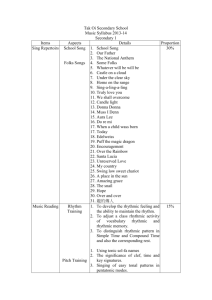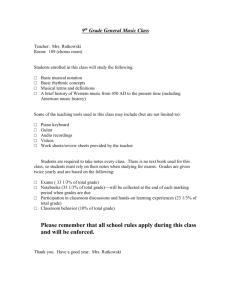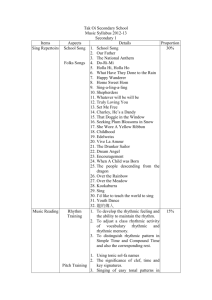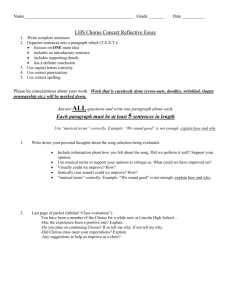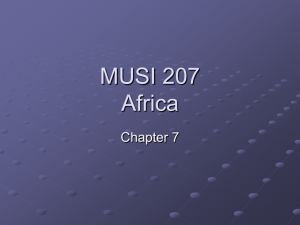A Survey of Traditional Music of West Africa
advertisement
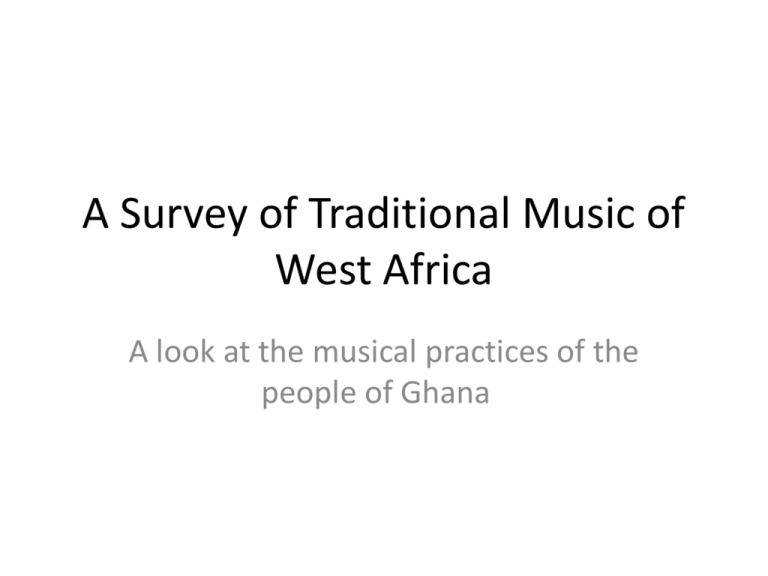
A Survey of Traditional Music of West Africa A look at the musical practices of the people of Ghana African Map The map of Ghana Regional map Socio-Cultural Influences/Issues • • • • • • External influence- Europeans. Western Classical Music- Practiced and enjoyed by very small segment of various societies. Western derived music- a preponderance of African musical elements married to certain foreign elements, especially those of the Western musical practices. Music performed on tribal basis and which, if it transcended its boundaries, did so because people who belonged to that tribe had travelled outside their tribe and had cause to use their music as a means of communication and social interaction. This tribal music , which has, for most part, successfully resisted the impact of acculturation and is still performed in its traditional contest, is what is classified as traditional African music. Example, Adowa, Bewa, Agbadza, Kete, Fontonfrom etc. After independence, African nations began to emphasize the projection of African personality and traditional cultures. Concert promoters were encouraged to put traditional African music in the theatre. Example is the Yoruba folk opera, Oba Koso, (The king did not hang), performed by Duro Ladipo and his cultural group from Nigeria in the 1970s. This kind of music has been designated “Neotraditional” by Akin Euba. Organization 1.Societies • Africans have lived in distinct societies, what we might think of as ethnic groups or tribes or clans. • There are over seven hundred languages spoken and within these languages are thousand more dialects. • Ghana alone has over 45 ethnic groups, each with it’s own language and dialects. • Separates societies and diverse geographical locations and occupations, along with differences in languages led to diverse musical practices. • Either through economic trade, political conquest, or social interaction, Africans have experienced cultural exchange between tribes. • We can divide Ghana into four broad categories: – – – – Southeastern Ghana- occupied by the Ewes and Gas Northwestern Ghana- occupied by Dargarti, Lobi, Wala and Sissala people Southern and Central Ghana- dominated by various Akans Northeastern Ghana- Dagombas, Mamprusi, Frafra. Talking drums. Organization 2.Music • In Africa, music is life; that is it permeates all daily activities. Music is the soul which is ultimately concerned with various customs and religious practices. • Some types of music or certain instruments might be restricted to specific events only. Adabatram music of the Asogli of Ghana, Kete of the Ashanti royal, Mmenson etc. There are also specified modes of music- men do not sing dirges, women do not play drums. • Because music forms an integral part of socio-cultural behavior, it may be organized as a form of entertainment, as an outlet for mass expression of sentiments and in connection with events of national significance. • Organization of music may be classified thus: – Recreational – Incidental – Ceremonial Performing Medium: Musical Instruments • Africans use musical instruments that vary greatly in construction and tone color. • We have five scientific classification of instruments: idiophones, menbranophones, chordophones, aerophones, and electrophones. Electrophones however do not form part of the African music tradition. Idiophones • Instruments the sound of which is produced by the vibration of the body of the instrument. These are usually solids that produce sound when beaten, and they are most widespread instruments in African musical environments. • Musical roles of the Idiophones include: – Provision of rhythmic accompaniment – Some, like the mbira and xylophone are used to generate songs in addition to the rhythmic accompaniment they provide – Used to provide signals-ceremonies and rites etc. • Division of the Idiophones: – Primary: include rattles, bells, clappers and xylophones- their sound are produced directly by hitting or shaking the instrument. – Secondary: include jingles, ankle/knee/wrist bells. The body of these instruments are set in vibration by the motion of something else, e.g. dancers leg. – Tuned Idiophones- xylophones and thumb piano are tuned to definite pitches and are therefore capable of producing melodies. – Non-tuned Idiophones produce only indeterminate pitches and cannot be used to play singable melodies: they are used to provide rhythmic accompaniment. • The basic role of the idiophone is to provide rhythmic patterns in accompaniment of music, but in some instances, idiophones may be used as talking “drums”-the slit drum is used to carry message from one person to the other. • Membranophones- instruments the sound of which is produced by the vibration of a stretched membrane or skin over a frame. These are generally known as drums; they may be made out of – – – – Logs of wood Strips of wood bound together by iron hoops- atimevu of the Anlo people Earthenware vessels Gourds etc. • Modes of Drumming: – Signal- short repetitive rhythmic patterns meant to carry messages to the community – Speech- characterized by steady flow of beats often lacking in regularity of phrasing but distributed between/among a number of tones frame work. – Dance –drumming is characterized by selective use of rhythms and tone patterns in recurring and contrasting sequences, manipulated unilinearly and/or multilinearly. Unlike the signal and speech modes of drumming, the dance mode is founded on regularity of pulse, crystallized by some of the rhythms of the subordinate drums/instruments in the ensemble. Bada & Donno (Dagomba) Fontonfrom Set (Akan) Kete Set (Akan) Atsiagbekor Set (Ewe) Kpalongo Set (Ga) • Chordophones– Instruments whose sound generator is a stretched string. Chordophones come in different types and sizes most are plucked or struck perhaps reflecting the African musicians predilection for percussive sounds. – Suitable for solo singing, or accompanying recitation of poetry, praise songs or narrative songs, Griots. – When found in heterogeneous ensembles, the accompanying instruments are usually played soft since string instruments are soft tuned. – Number of strings may vary from one instrument ranging from one string to as many as twenty-one strings. • Types: – The musical bow: the mouth bow and the earth bow. – Fiddles, includes the gonje played with a horsetail bow; harps and lutes, zithers. – Harp-lutes: The kora of Mandingo people of Sene-Gambia and the seprewa of Ghana are good examples of the Harp-lute. Gonje Kora • Aerophones: – Musical instruments whose sound is produced by the vibration of an aircolumn. – This category of instruments is less common in Africa. – The most common found includes flutes made out of bamboo, husks of cane, stalks of millet or the tip or “horn” of gourd, or they may be carved out of wood. – Some flutes are made out of clay while others are fashioned out of the shell of fruits or sea shells. – They may be played in transverse or end-blown position – There are also horns and trumpets which are made from animal horns, elephant tusks, wood, bamboo and gourds. – Mmenson of Ghana may be carved out of horns, ivory tusks of elephants or out of woods. Choric Organization of African songs • The simplest form of African songs is the call-and-response form. It consists of a phrase of two sections (a & b) sung alternately by a cantor (or lead singer) and a chorus; and may be repeated over and over. • These songs are mostly featured in: – Children songs – As interludes to intersperse story telling with the sole aim of creating activeness to and interest in the narration – Asafo (warrior) songs • In the context of such songs, the primary focus is on the movement accompanied by the songs: the action of the game, the procession of the match; the music merely provides the stimulus; its musical considerations are subservient to the movement and/or actions the music accompanies. • Despite the shortness and simplicity of these types of songs, interest is sustained and boredom eliminated by the employment of various techniques. The following are a few of such techniques. – Variation in text: melody of the cantor may remain the same, but the text sung to the melody may be varied. – Variation in the melody: text remain the same, but the melody to which the text are sung are varied. – Variation in both melody and texts: appropriate modifications are made in the melodic line if the structure of the texts so demand. This is necessary so that the curve of the melody reflects the pitch inflections and rhythms of the text Solo and Chorus • Solo and chorus form is the construction of songs of two to eight (or more) phrases of strophic or verse-repeating (stanzaic) character. • Solo and chorus form are not conceived on the same principle of alternation. In this form, the cantor merely introduces the song which is then repeated by the chorus. • This may be done in one of two ways. – The cantor may sing the entire verse of the song once through, the chorus repeating after him. – The cantor may sing a short introductory phrase after which the chorus sings the main song. • For sustaining interest in the performance of songs in solo and chorus form, the following techniques are employed. – A cantor may sing a short leading phrase before the entry of the chorus, after he has sung his part ( an addition to the introduction) – A cantor may interrupt the main chorus at appropriate points forcing the chorus to go back to the beginning or to begin a new episode. – A number of cantors may take turns in leading the chorus. – Cantors may lead in twos. Sporadic Pitch Combination • In this style choric organization, the ensemble sings a given melody in unison. Occasionally, when a choice of melodic direction is possible, a song may break into two-pats and quickly return to the basic linear form. Rhythmic Organization In African Music • African Music can, generally, be termed music of the dance; that is to say, each musical piece is a synthesis of many fabrics, one or two of which dictate dance steps and movements. • There are, however, a few exception to this generalization, and these are manifested in the few isolated cases of non-danceaccompanied and non-dance prompting music which has designated “contemplative music”. • When a piece of music is associated with dance, it has elements of musical texture which can be articulated in bodily movements or “at can excite the dance tendencies of an indigene”. • Since dance is very elemental to African musical traditions, rhythm is much more emphasized than other musical elements. • It is the rhythmic organization in a piece of music that defines, and, in most cases, dictates the patterns of movements of the dancer. • In African music movement has rhythmic implication ,that is, both instrumental and vocal music have not only patterns of tone but patterns of definite rhythmic organization. • Because of the predilection for rhythmic sophistication, a number of rhythmic devices and techniques for producing them are employed in African musical practices. – Ostinato- short pattern or figure that is repeated over and over • Time line to help crystallize the foundation pulse by maintaining a rhythmic ground for the music. • Rhythmic accompaniment. Participated mediary drums functioning not only as accompanying drums but also adding to the richness and density of the rhythmic design. – The Hemiola- The regular divisions of the time span in alternating sections of duple and triple meter. A combination of two equal duple and triple sections. – Formation of Rhythm Patterns • Divisive rhythms: are those rhythms in which the regular divisions of the time span are articulated; the notes in the time span are grouped so that they follow the scheme of pulse structure. They follow the internal divisions of the time span. • Additive rhythms: the durational values of some notes are extended beyond the regular divisions within the span. Instead of note groups or sections of the same length, different groups are combined in the span.
